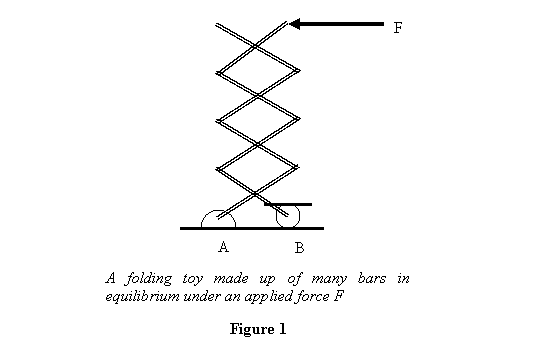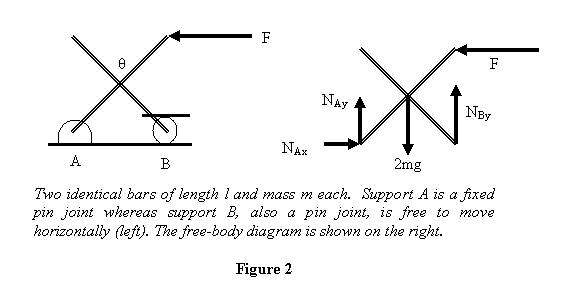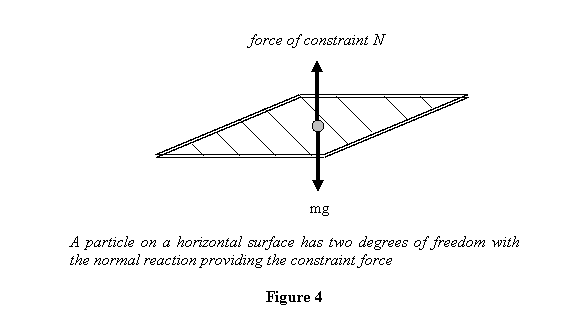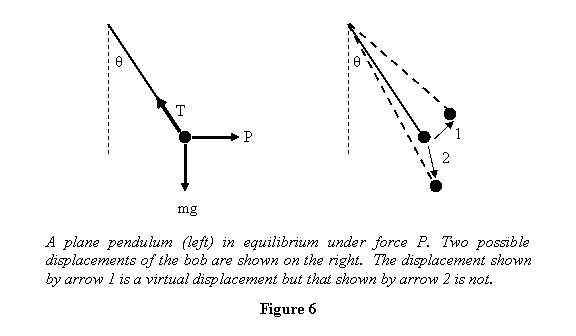So far when dealing with equilibrium of bodies/trusses
etcetera, our strategy has been to isolate parts
of the system (subsystem) and consider equilibrium
of each subsystem under various forces: the forces
that we apply on the system and those that the surfaces,
and other elements of the system apply on the subsystem.
As the system size grows, the number of subsystems
and the forces on them becomes very large. The question
is can we just focus on the force applied to get
it directly rather than going through each and every
subsystem. The method of virtual work provides
such a scheme. In this lecture, I will give you a
basic introduction to this method and solve some
examples by applying this method.
Let us take an example: You must have seen a children's
toy as shown in figure 1. It is made of many identical
bars connected with each other as shown in the figure.
One of the lowest bars is connected to a fixed pin
joint A whereas the other bar is on a pin
joint B that can move horizontally. It
is seen that if the toy is extended vertically, it
collapses under its own weight. The question is what
horizontal force F should we apply at its
upper end so that the structure does not collapse.

To see how many equations do we have to solve in finding F in
the structure above, let us take a simple version
of it, made up of only two bars, and ask how much
force F do we need to keep it in equilibrium (see
figure 2).

Let each bar be of length l and mass m and
let the angle between them be θ. The
free-body diagram of the whole system is shown above.
Notice that there are four unknowns - NAx ,
NAy , NBy and F - but
only three equilibrium equations: the force equations

and the torque equation

So to solve for the forces we will have to look at
individual bars. If we look at individual bars, we
also have to take into account the forces that the
pin joining them applies on the bars. This introduces
two more unknowns N1 and N2 into
the problem (see figure 3). However, there are three
equations for each bar - or equivalently three equations
above and three equations for one of the bars - so
that the total number of equations is also six. Thus
we can get all the forces on the system.

The free-body diagrams of the two bars are shown in
figure 3. To get three more equations, in addition
to the three above, we can consider equilibrium of
any of the two bars. In the present case, doing this
for the bar pinned at B appears to be easy so we
will consider that bar. The force equations for this
bar give

And taking torque about B , taking N1
= 0 , gives

This then leads to (from the force equation above)

Substituting these in the three equilibrium equations
obtained for the entire system gives

Looking at the answers carefully reveals that all
we are doing by applying the force F is
to make sure that the bar at pin-joint A is in equilibrium.
This bar then keeps the bar at joint B in equilibrium
by applying on it a force equal to its weight at
its centre of gravity.
The question that arises is if we have many of these
bars in a folding toy shown in figure 1, how would
we calculate F ? This is where the method
of virtual work, to be developed in this lecture,
would come in handy. We will solve this problem later
using the method of virtual work. So let us now describe
the method. First we introduce the terminology to
be employed in this method.
1. Degrees of freedom: This is the
number of parameters required to describe the system.
For example a free particle has three degrees of
freedom because we require x, y , and z to
describe its position. On the other hand if it is
restricted to move in a plane, its degrees of freedom
an only two. In the mechanism that we considered
above, there is only one degree of freedom because
angle θ between the bars is sufficient
to describe the system. Degrees of freedom are reduced
by the constraints that are put on the possible motion
of a system. These are discussed below.
2. Constraints and constraint forces: Constraints
and those conditions that we put on the movement
of a system so that its motion gets restricted. In
other words, a constraint reduces the degrees of
freedom of a system. Constraint forces are the forces
that are applied on a system to enforce a constraint.
Let us understand these concepts through some examples.
A particle in free space has three degrees of freedom.
However, if we put it on a plane horizontal surface
without applying any force in the vertical direction,
its motion is restricted to that plane. Thus now
it has only two degrees of freedom. So the constraint
in this case is that the particle moves on the horizontal
surface only. The corresponding force of constraint
is the normal reaction provided by the surface.

As the second example, let us take the case of a vertical
pendulum oscillating in a plane (see figure 5). Thus
its degrees of freedom would be two if there were
no more constraints on its motion. However, the bob
of a pendulum is constrained to move in such a way
that its distance from the pivot point remains fixed.
We have thus introduced one more constraint on its
motion and therefore the degrees of freedom are reduced
by one; a pendulum oscillating in a plane has only
one degree of freedom. The angle from the equilibrium
position is therefore sufficient to describe a plane
pendulum's motion fully. How about the force of constraint
in this case? The constraint, that the distance of
the bob from the pivot point remains fixed, is ensured
by the tension in the string. The tension in the
string is therefore the force of constraint.

Let us now consider the folding toy shown in figure
1. This structure, although made of many moving bars,
has only one degree of freedom because the bars are
constrained to move in a very specific way. Thus
from a large number of degrees of freedom for these
bars, all of them except one are eliminated by the
constraints. As such the number of constraints, and
therefore the number of constraint forces, is very
large. The constraint forces are the reactions at
the supports A and B and the forces applied by the
pins holding the bars together. It is because of
these forces that the system is restricted in its
motion.
I would like you to note one thing interesting in
the examples considered above: if the system moves
the constraint forces do not do any work on it. In
the case of a particle moving on a plane, the motion
is perpendicular to the normal reaction so it does
no work on the particle. In the pendulum the motion
of the bob is also perpendicular to the tension in
the string which is the force of constraint. Thus
no work is done on the bob by the constraint force.
The case of the toy in figure 1 is quite interesting.
In the structure point A does not move and the motion
of point B is perpendicular to the reaction force
at B. Thus there is no work done by the reaction
forces at these points. On the other hand, the constraint
forces due to pins connecting two bars are equal
and opposite on each bar. But the points on the bar
where these forces act (the points where the pin
joints are) have the same displacement for each bar
so that the net work done by the constraint forces
vanishes.
3. Virtual displacement: Given a
system in equilibrium, its virtual displacement is imagined as
follows: Move the system slightly away from its equilibrium
position arbitrarily but consistent with the constraints.
This represents a virtual displacement of the system.
Note the emphasis on the word imagined. This is because
a virtual displacement is not caused by the applied
forces. Rather it is the difference between the equilibrium
position of the system and an imagined position -
consistent with the constraints - of the system slightly
away from the equilibrium. For example in the case
of a pendulum under equilibrium at an angle θ under
a force P (see figure 6), virtual displacement
would be increasing the angle from θ to ( θ
+ Δθ) keeping the distance of the
bob from the pivot unchanged. On the other hand,
moving the bob with a component in the direction
of the string is not a virtual displacement because
it will not be consistent with the constraint. Virtual
displacement is denoted by  to
distinguish it from a real displacement
to
distinguish it from a real displacement  .
.

4. Virtual work: The work done by
any force  during
a virtual displacement is called virtual work. It
is denoted by
during
a virtual displacement is called virtual work. It
is denoted by  .
Thus
.
Thus

Note that our previous observation, that work done
by a constraint force is usually zero, implies that
virtual work done by a constraint force is also zero.
Also keep in mind that in calculating the work  done
by the force
done
by the force  ,
,  represents
the displacement of the point where the force is
being applied.
represents
the displacement of the point where the force is
being applied.
With these definitions we are now ready to state the
principle of virtual work. It is based on the assumption
that virtual work done by a constraint force is zero.
The principle of virtual work states that " The
necessary and sufficient condition for equilibrium
of a mechanical system without friction is that the
virtual work done by the externally applied forces
is zero ". Let us see how it arises. For a system
in equilibrium, each particle in the system is in
equilibrium under the influence of externally applied
forces and the forces of constraints. Then for the ith particle

Therefore

But we have already seen that for individual particles  and
for a system composed of many subsystems
and
for a system composed of many subsystems  ,
that is the net virtual work done by constraint forces
is zero. This means that the total virtual work done
by the external forces vanishes, i.e.
,
that is the net virtual work done by constraint forces
is zero. This means that the total virtual work done
by the external forces vanishes, i.e.

This is the necessary part of the proof. The condition
is also sufficient condition. This is proved by showing
that if the body is not in equilibrium, the virtual
work done by the external forces does not vanish
for all arbitrary virtual displacements (consistent
with the constraints). If the body is not in equilibrium,
it will move in the direction of the net force on
each particle. During this real displacement  the
work don by the force on the ith particle
will be positive i.e.
the
work don by the force on the ith particle
will be positive i.e.

Now we can choose this real displacement to be the
virtual displacement and find that when the body
is not in equilibrium, all virtual displacements
consistent with the constraints will not give zero
virtual work. Thus when the system is not in equilibrium

Assuming again that the net work done by the constraint
forces is zero, we get that for a body not in equilibrium

This implies that when the virtual work done by external
forces vanishes, the system must be in equilibrium.
This proves the sufficiency part of the condition.
We now solve some examples to illustrate how the
method of virtual work is applied.